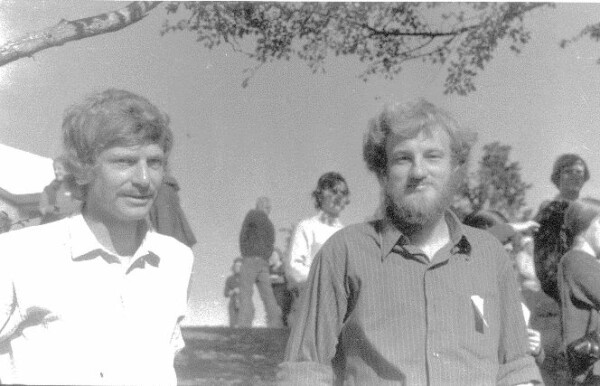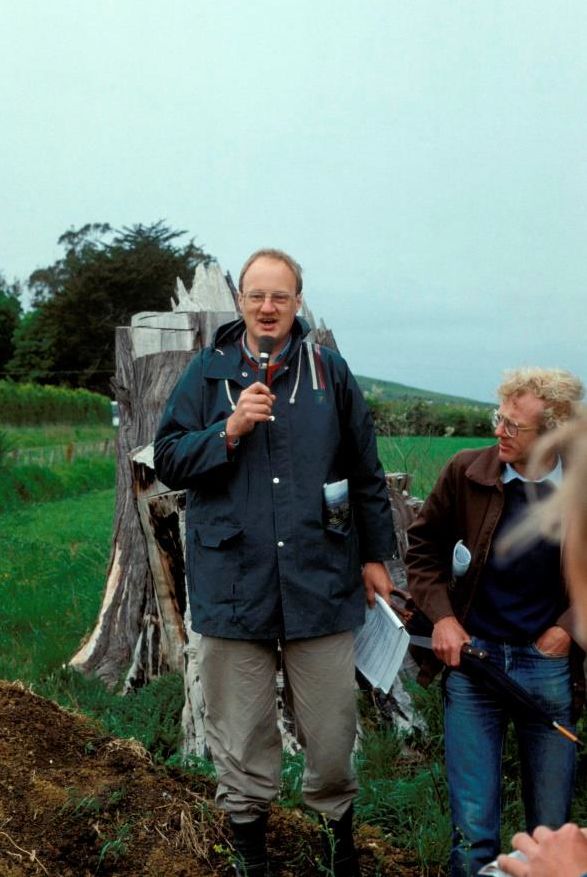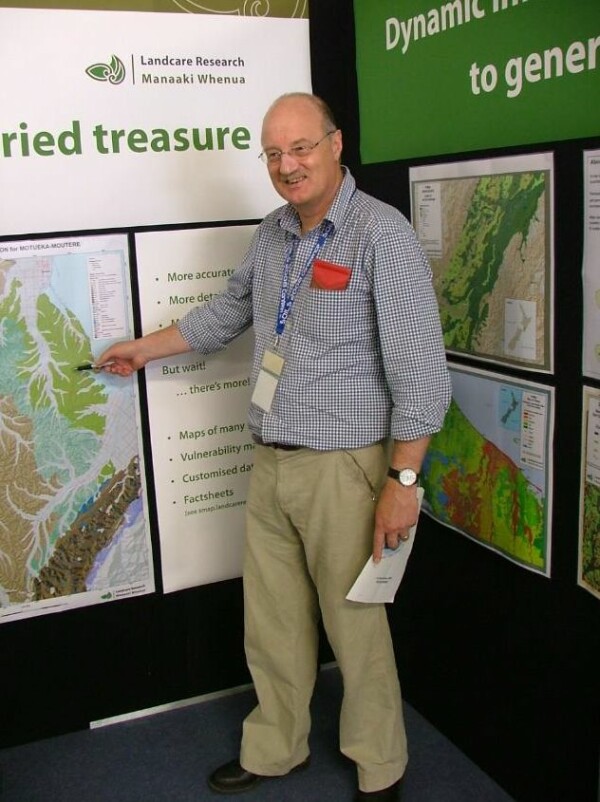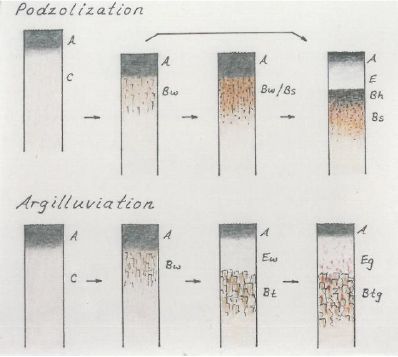Allan E. Hewitt - a multi-talented soil scientist
Sadly, Allan Hewitt passed away on Thursday March 24th, 2022.
Allan is remembered fondly by his colleagues in soil science throughout New Zealand and his Manaaki Whenua co-workers especially those in our Dunedin and Lincoln offices.
Allan’s formative years were based in Canterbury, growing up on farms in the Little River and Greenpark areas. Allan recalled how his interest in soils began in rural Canterbury when he was fascinated by the different colours evident in a road cutting.

Ian Lynn (left) and Allan in their Uni years
After completing a BSc (Hons) (Geology) at the University of Canterbury and a Post-Graduate Diploma in Agriculture Science (Soil Science) at Lincoln University, Allan joined the DSIR Soil Bureau in Dunedin in 1974. Bill Lee recalls first meeting Allan on a field trip to Red Mountain, NW Otago, in the mid-1970s: “I was studying soil/plant relations and was very excited to have a real soil scientist around. The week we spent digging and describing soils on the ultramafic scree was the start of an enduring friendship with Allan and Liz”. This recollection nicely reflects Allan’s ‘friendship’ based approach to his career. Over the years Allan was involved in a great variety of projects, often multi-disciplinary, out of which Allan built an admirable diversity and breadth of friendships of which many of us have fond memories.
During Allan’s years in Dunedin, he was responsible for several southern based projects, including the innovative soil map of the Waipori Farm Settlement (report | map), which partly laid the foundations for the emerging concept of soil-landscape modelling, and arguably the most accurate and comprehensive soil map ever published, ‘Soils of the Cromwell Gorge’ (report | map). This survey is now safeguarded from re-examination and reinterpretation by occupying the floor of Lake Dunstan, behind the Clyde Dam! When mapping the soils of the Cromwell Gorge, Allan inserted a sketch showing the complex landscape and the different soils. For his own amusement, he included another sketch alongside showing a dam and a lake with no soils evident – labeling them “Before” and “After”. He thought they would be edited out as it was at a time when having a sense of humour was not a professional requirement in the DSIR, but somewhat to his embarrassment they remained in the final document. Allan was also involved in several North Island team surveys, and Pacific Island work mapping one of the Tongan Islands with Hugh Wilde.
Between 1979 and 1982, Allan worked on his PhD at Cornell University. His thesis, ‘Decisions in the establishment of soil series’ was a precursor to his work on reviewing and establishing the ‘New Zealand Soil Classification’ (NZSC), now in its 3rd edition. He returned to DSIR Soil Bureau as a District and then Regional Pedologist, before becoming Senior Pedologist and Research Leader at Manaaki Whenua- Landcare Research, until his retirement in 2015. He moved from Dunedin to Lincoln in 2001.

Allan presenting during the 1990 NZSSS Otago conference
Allan made an outstanding scientific contribution to soil classification, land evaluation and soil mapping, both in New Zealand and overseas. The NZSC has become the accepted source for naming, characterising, mapping, sampling, and reporting for the national inventory of soils in New Zealand. International recognition of the NZSC is evidenced by full translation into Spanish and subsequent adoption of many of its features in the new Soil Classification for China. When on the International Soil Science committee, Allan queried the term “Man-made soils” being suggested. He discovered that in fact most of the soils of the world are dug by women (Asia, Africa), and he ensured this was acknowledged.
The classification, launched at the New Zealand Society of Soil Science (NZSSS) Conference in Rotorua in 1992, was the culmination of over 10 years of work by Allan and others that began in 1983 when the New Zealand Soil Bureau decided not to adopt “Soil Taxonomy” as the principal means of soil classification.
At all stages during development, draft copies of the emerging NZSC (including version 1.0 in 1987 and version 2.0 in 1988-89) were sent to interested soil scientists throughout New Zealand for review and testing, and specialists were asked to contribute by defining diagnostic features for specific soil classes. David Lowe remembers pedology students at Waikato University testing the draft versions during David’s annual Northland field trip. The names used for the orders during the developmental stages were regarded as informal and not up for discussion at that point because Allan wanted “to avoid useless argument”.
In 1987, Allan was brave enough to state that his forthcoming classification “will deliver the goods to those concerned for the stewardship of New Zealand soils” (NZ Soil News 35, p. 243). All agree that Allan delivered on his promise. He assiduously documented the progress of the classification through seminars and reports (including regular updates in NZ Soil News), and subsequently published two reviews in 1993 to document its basis and rationale: “Soil classification in New Zealand – legacy and lessons” (Australian Journal of Soil Research 30, 843-854) and “Methods and rationale of the New Zealand Soil Classification (Landcare Research Science Series 2). In doing this, Allan had worked quite closely with Ray Isbell, CSIRO, who was developing a new “Australian Soil Classification” at the same time (published in 1996). Later, Allan summarized the NZSC as a new appendix for the second edition (1998) of Les Molloy’s book “Soils in the New Zealand landscape”. A detailed history of the journey of soil classification in New Zealand is being prepared by Phil Tonkin, and will be featured in a future edition of NZ Soil News.
To meet the demands for digital descriptions of soil characteristics needed by land management industries, regional and national policy organisations for planning consents and research and education, Allan promoted the extension of the NZSC into New Zealand’s spatial soil information system (S-map). This national ongoing initiative built on the turn-of-the millennia Topoclimate Southland and GrowOtago regional projects, where Allan played a pivotal mentoring and correlation role. It is a tribute to the collaboration and dedication between Allan, Linda Lilburne, Trevor Webb and Ian Lynn that S-map was kept alive in its early years. Allan also considers one of his most important contributions was to the development of a large computer database of soil profiles throughout New Zealand, now known as the National Soil Database Repository (NSDR).
In the 2000s Allan also played a significant role in the pan-CRI SLURI programme, helping pioneer the concepts of soil natural capital and ecosystem services, the influence of which we see today in the shaping of national land policy, environmental reporting, and the business case that has underpinned Government support of S-map.

Allan at the Massey joint NZSSS and AUSSS conference, Massey 2008
Allan’s lifetime contribution to soil classification has provided the foundation for training an entire generation of under-graduates, emerging scientists, and farmers with the critical skills for soil and land management across New Zealand. The wide use of Allan’s soil classification has enhanced the reputation of New Zealand for its research and teaching in soil science.
Allan’s impact on soil classification, as well as soil science more broadly has been recognised nationally with prestigious awards, including the NZSSS’s Norman Taylor Lecture, and the Leamy Award (for “most meritorious New Zealand contribution to soil science”). Roles have also included the President of NZSSS (2010-12) and invited keynotes at soil science conferences in Australia, Europe and the United States. His interest in soil classification and soil taxonomy served him well. As a member of international soil taxonomy committees, he visited all the world’s continents, except Africa, and some 18 countries including Brazil, and Japan. He has also managed to wrangle a summer field season in Antarctica.
Allan was awarded the prestigious Lincoln University Bledisloe Medal at the 2019 Graduation ceremony on 3rd May 2019. The Bledisloe Medal is awarded to a former student or past or current staff member of Lincoln University who, in the opinion of the Lincoln University Council, has made an outstanding contribution in his or her chosen field, advanced New Zealand’s interests, and/or brought credit to Lincoln University.
Allan contributed prominently within the wider community and was highly regarded for his integrity and as a mentor. With his quiet and dignified manner, Allan listened carefully and was always willing to offer valuable advice. Allan was very personable and highly regarded by his colleagues and friends. He was a lay preacher, and heavily involved in church boards, especially when based in Dunedin. For more than 20 years Allan was a home group host and mentor to many students. There are several emerging and leading scientists benefiting from Allan’s support, wisdom, and faith in their ability during their formative years. He also cared for the gardens of several elderly ladies. Since moving to Rolleston in 2001 he spent his free time developing a large garden from a bare stony paddock (classic Lismore shallow and stony soils). Allan was a skilled landscape painter and has often used soil as a medium for his art. Some of his paintings were on display at the NZSSS Meeting in Hamilton in 2014 and exhibited in Christchurch in 2021. He used paintings to illustrate soil-forming processes and the development of associated soil profiles in New Zealand and elsewhere for his N.H. Taylor Memorial Lecture in November 1996 (“Are New Zealand soils distinctive? A subterranean view of New Zealand ecosystems”, NZ Soil News 45, 7-16, 1997), and generously donated copies of his fine artwork to David Lowe to use in his lectures at Waikato University.

Allan’s contrasting processes and profiles used in his 1996 Norman Taylor Lecture (NZ conditions tend to favour podzolization)
For Allan, soil pits or road cuttings were his joy and happy place, his library and databank, even his art. Pedological pits were his window through which he began to understand the creation of the landscape. For Allan soils were informative for understanding landscape, they were the product of time and conditions, often long past, and they were a vulnerable resource for humans to use with care.
Soil horizons for Allan were where knowledge of the landscapes become apparent. He was fascinated with the colour, texture, and composition of soil profiles, and many of us have fond memories of Allan in a hole, dressed in his field jacket with pockets containing tools for assessing colour, texture and composition, limbs covered in soil, and Allan’s beaming smile as he wrote his observations into his notebook. In the evenings he would often draw sketches of landscapes, showing his ideas on how the soils were linked by origin or process. Crucially, for Allan soils were beautiful, features to be studied and enjoyed, as his paintings show.
Allan’s deep lifelong commitment and passion for all things soil is very nicely summarised by the age he ascribed to himself in a biography provided for the IUSS: Mature, active, moderately weathered, partly eluviated, 0.06 ka!
Allan was the dearly loved husband of Liz, cherished father of Sarah and Tim and "Grandmandad" of Elijah and Alice.
This obituary was first published in NZSSS Soil News Vol. 70(2). Contributions were kindly provided by Jackie Aislabie, Bill Lee, Ian Lynn, Sam Carrick, David Lowe and Megan Balks.